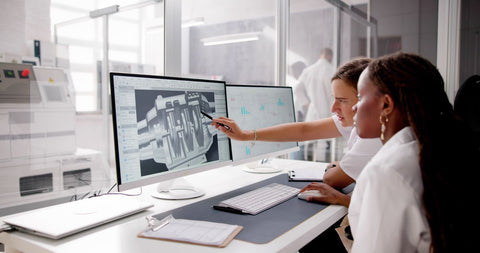3D CAD Modeling: Unlocking New Dimensions in Design and Engineering

Design and engineering have always been at the forefront of human innovation. They have evolved from simple tools and structures to the complex systems and marvels of modern architecture and machinery we see today. Advancements in technology, particularly in how we create and conceptualize designs, have significantly shaped this journey of progress. Enter the 3D CAD (Computer-Aided Design) modeling era, a revolutionary leap forward from traditional drafting methods.
3D CAD modeling has transformed the landscape of design and engineering, offering a digital canvas where ideas take shape with precision and clarity that pen and paper can’t match. This technology allows designers and engineers to construct detailed three-dimensional representations of their projects, enabling a level of visualization and experimentation that was previously unimaginable.
The significance of CAD modeling lies in its ability to streamline the design process and its capacity to bridge the gap between conceptualization and realization, making it an indispensable tool in today’s design and engineering fields.
The transformative impact of CAD modeling is profound, reshaping every aspect of planning, developing, and executing projects. It has opened new dimensions in design and engineering, fostering innovation, enhancing efficiency, and ultimately creating better, more sustainable solutions. As we delve deeper into the capabilities and applications of 3D CAD modeling, it becomes clear that this technology is redefining what we can achieve.
The fundamentals of 3D CAD modeling
3D CAD modeling is a process that uses software to create precise, detailed three-dimensional models of objects or systems.
Unlike traditional 2D design methods, which rely on flat drawings and sketches to represent ideas, 3D CAD modeling brings designs to life in a virtual space, allowing for a more comprehensive view of how a project will look and function in the real world.
This shift from 2D to 3D modeling has revolutionized the design and engineering industries by providing a more dynamic, interactive, and accurate way to visualize and test ideas before they are built.
One of the key differences between 3D CAD modeling and traditional 2D design methods is the level of detail and accuracy that designers can achieve. With 3D CAD, designers and engineers can explore every aspect of their designs, from the overall structure down to the smallest components, in a way that isn't possible with flat drawings. This not only improves the quality of the final product but also reduces the likelihood of errors and the need for costly revisions during the construction or manufacturing process.
Modern CAD software comes packed with a range of features and capabilities designed to enhance the design process. These include advanced simulation tools that allow users to test the performance of their designs under various conditions, collaboration features that enable teams to work together seamlessly on projects, and customization options that cater to the specific needs of different industries.
Additionally, many CAD programs offer integration with other software, making managing projects from design to production easier.
3D CAD modeling is a powerful tool that opens up new possibilities for creativity and innovation in design and engineering. CAD modeling has become an essential part of the modern design process by providing a more accurate, efficient, and flexible way to create and test designs.
Revolutionizing design processes
3D CAD modeling has fundamentally transformed the design process, ushering in a new era of precision, efficiency, and creativity. This technology has enabled designers and engineers to push the boundaries of what's possible, bringing to life complex designs that were once too challenging or even impossible to achieve.
From intricate architectural structures to sophisticated machinery parts, CAD modeling has made it possible to visualize, refine, and realize designs with unprecedented detail and accuracy.
One of the most striking examples of complex designs made possible through CAD modeling is the construction of modern skyscrapers, which feature unique, often unconventional shapes and structures. CAD modeling allows architects to experiment with these complex geometries, ensuring structural integrity while achieving their aesthetic vision.
Similarly, engineers in the automotive industry use CAD software to design vehicles with intricate components and systems, optimizing performance and safety without compromising style.
Beyond making complex designs achievable, CAD modeling is crucial in enhancing creativity and innovation in the design process. With the ability to quickly modify and test different iterations, designers are free to explore a wider range of ideas and solutions. This iterative process encourages experimentation and pushes the design envelope, leading to breakthroughs and innovations that redefine products, buildings, and even entire industries.
Moreover, CAD modeling facilitates collaboration among multidisciplinary teams, enabling them to work together more effectively on shared projects. This collaborative environment fosters a cross-pollination of ideas, further driving creativity and innovation.
By providing the tools to visualize, simulate, and collaborate, 3D CAD modeling has become an indispensable asset in the design process, empowering professionals to create more sophisticated, functional, and visually appealing designs than ever before.
Impact on engineering and manufacturing
3D CAD modeling has significantly impacted engineering practices, revolutionizing how professionals design, engineer, and manufacture products. This technology has become a cornerstone in modern engineering, facilitating precision, efficiency, and cost-effectiveness throughout manufacturing.
By enabling engineers to create detailed digital prototypes, CAD modeling minimizes the need for physical prototypes, reducing both the time and expenses associated with product development.
CAD modeling enhances precision in engineering by allowing for the meticulous design of components and systems. This precision ensures that parts fit together perfectly, reducing assembly issues and improving the overall quality of the final product.
Moreover, CAD software comes equipped with simulation tools that predict a design's performance under various conditions. This capability allows engineers to identify and rectify potential issues before production, further ensuring the reliability and safety of manufactured goods.
Efficiency in manufacturing is another area where CAD modeling makes a significant impact. By streamlining the design process, CAD allows for quicker iterations and modifications. This agility speeds up the development cycle, enabling companies to bring products to market faster.
Additionally, the detailed documentation generated by CAD models facilitates clear communication between design teams and manufacturing units, ensuring that products are manufactured accurately the first time.
By enabling precision, efficiency, and cost-effectiveness, CAD modeling pushes the boundaries of what's possible in engineering projects, driving innovation and excellence in manufacturing.
The future of CAD modeling in design and engineering
As we look toward the horizon, the future of CAD modeling in design and engineering appears promising and transformative. Advancements in CAD technology are set to revolutionize these fields further, making design and manufacturing processes even more efficient, precise, and innovative.
One can anticipate the integration of Artificial Intelligence (AI) and machine learning into CAD systems, enabling smarter, more intuitive modeling tools that predict user needs and automate routine tasks. This evolution will speed up the design process and open new avenues for creativity and problem-solving.
Sustainability is becoming increasingly crucial in all aspects of design and engineering, and here, too, CAD modeling is playing a pivotal role. Experts expect future CAD systems will incorporate advanced sustainability analysis tools, allowing designers and engineers to assess the environmental impact of their projects in the early stages of design. This capability will enable the creation of more eco-friendly and resource-efficient products and structures, aligning with global efforts to combat climate change and promote sustainability.
However, the path to fully leveraging advanced CAD modeling techniques has its challenges. The complexity of next-generation CAD software may require significant training and skill development for users. Additionally, the integration of new technologies like AI and virtual reality into CAD systems will necessitate robust data security measures to protect sensitive project information.
Despite these challenges, the opportunities presented by advanced CAD modeling are immense. As CAD technology continues to evolve, it will empower professionals to tackle more complex projects, drive innovation in design and manufacturing, and contribute to a more sustainable future. For those ready to embrace these advancements, the future of CAD modeling offers a landscape of limitless possibilities, promising to reshape the world of design and engineering in profound ways.
Unlock your project’s potential with ProSoft
We've explored the transformative role and benefits of 3D CAD modeling in design and engineering, highlighting its impact on precision, efficiency, and innovation. As we embrace the future, the importance of advanced CAD tools in driving sustainable and creative solutions is undeniable.
Enter ProSoft, your trusted partner in navigating this evolving landscape. ProSoft stands at the forefront of providing cutting-edge software and hardware solutions meticulously tailored to the needs of design and engineering professionals. Our commitment is to empower you with the tools necessary to bring your visionary projects to life.
We invite you to explore ProSoft's comprehensive offerings and discover how our state-of-the-art hardware and software solutions can elevate your projects. Choose ProSoft for unparalleled technology solutions that promise to enhance your design and engineering outcomes. Join us in shaping the future, one design at a time.



